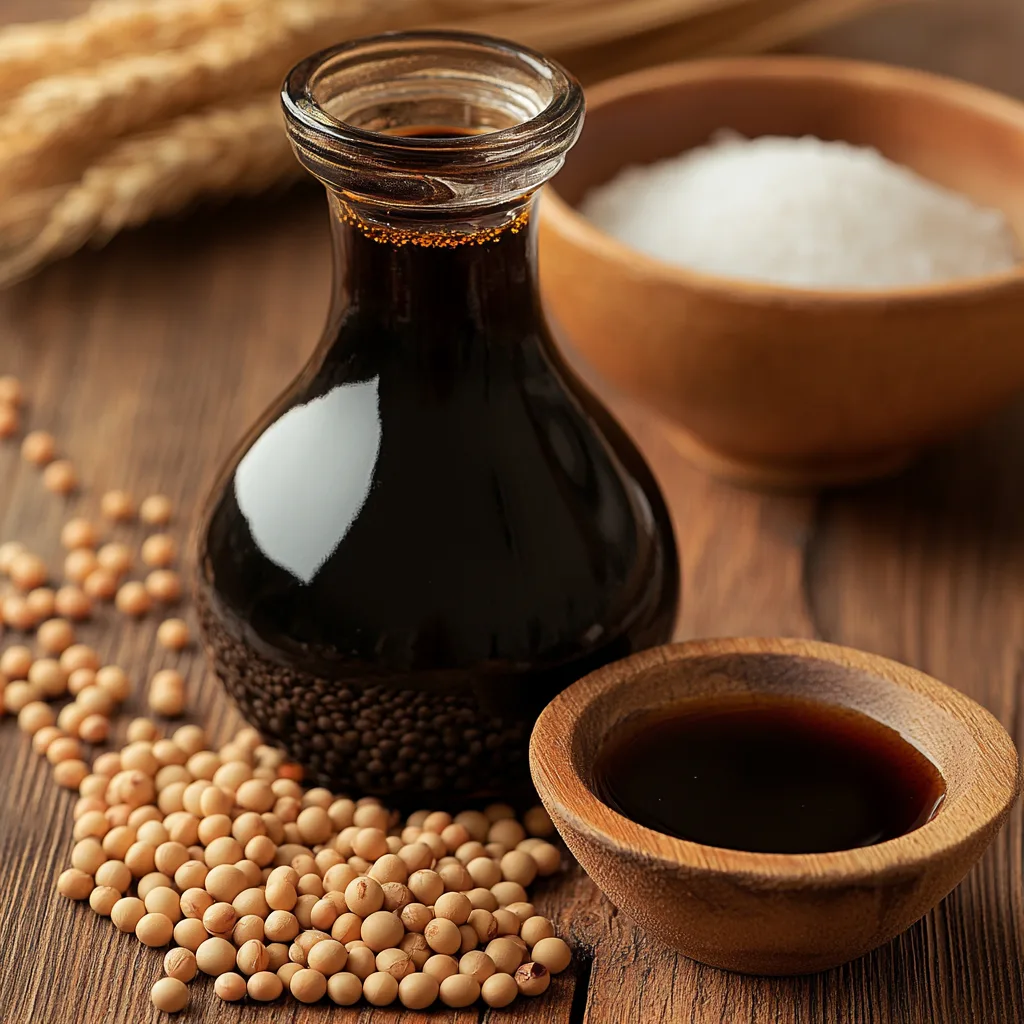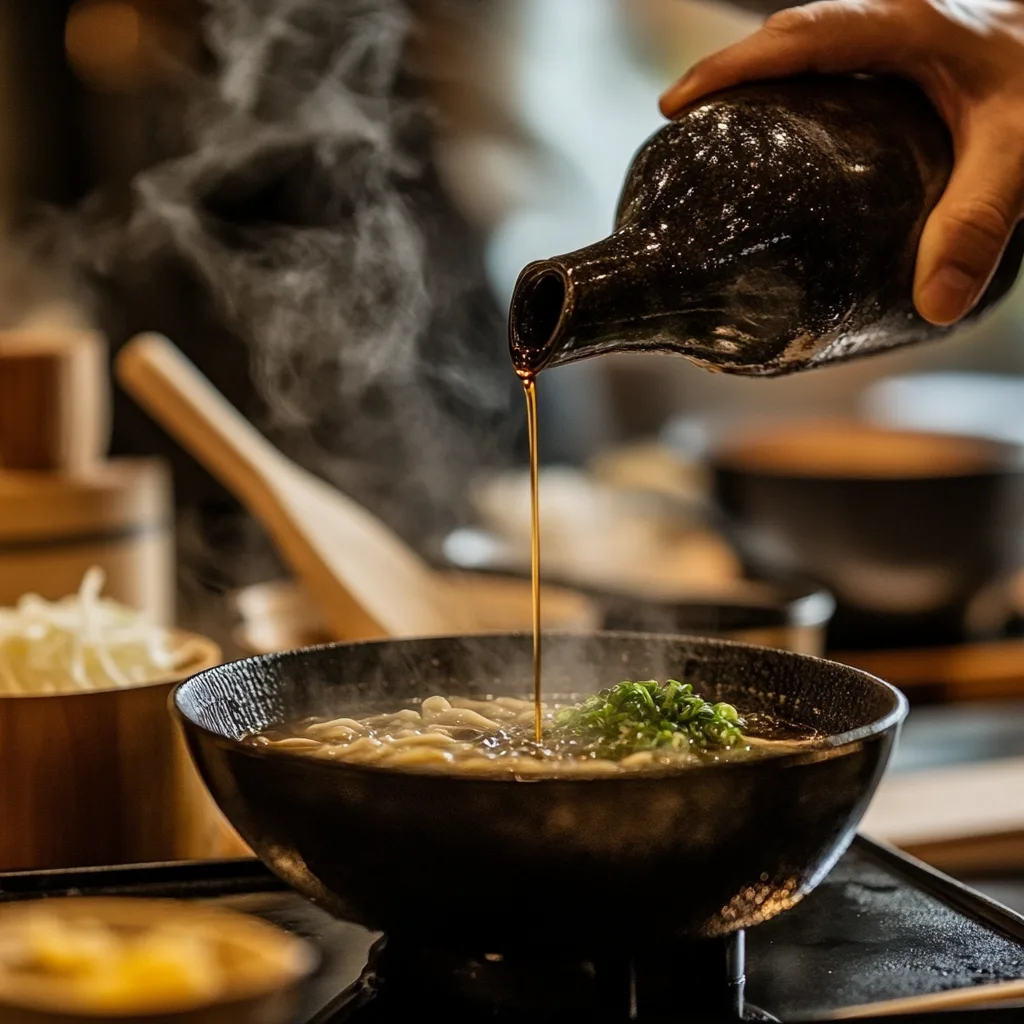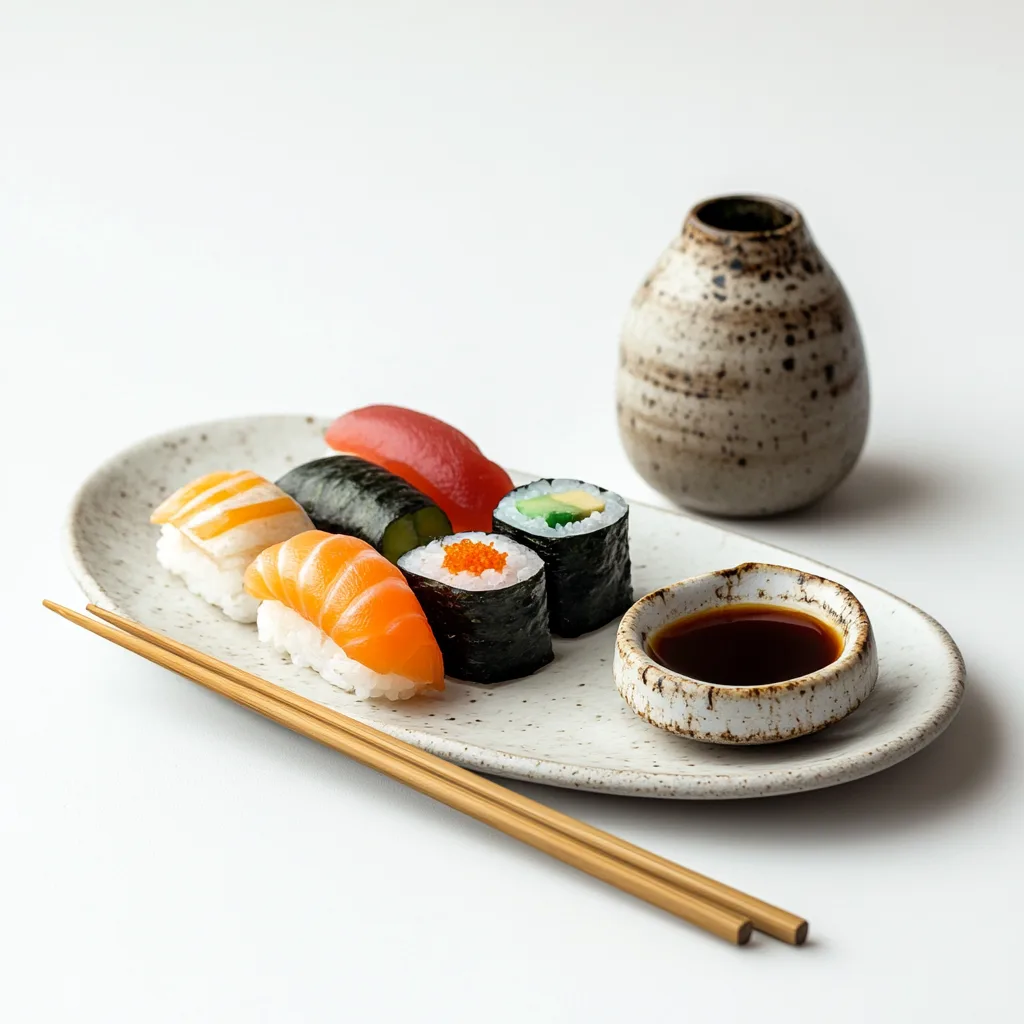1. Introduction
When you think of Japanese cuisine, what comes to mind? Perhaps it’s sushi, ramen, or teriyaki. Behind many of these iconic dishes lies a single, essential ingredient: shoyu sauce. Known as Japanese soy sauce, shoyu is celebrated for its delicate balance of salty, sweet, and umami flavors. It’s a staple in kitchens not just in Japan, but worldwide.

Alt Text: Traditional shoyu sauce bottle surrounded by soybeans, roasted wheat, and a bowl of dark soy sauce.
This guide will take you on a journey through the world of shoyu sauce. You’ll discover its rich history, how it’s made, the different types available, and how to use it in your cooking. Whether you’re a food lover or a curious cook, this comprehensive article will provide all the knowledge you need to appreciate and use shoyu sauce effectively.
2. What is Shoyu Sauce?
At its core, shoyu sauce is a liquid condiment made by fermenting soybeans, wheat, salt, and water. The fermentation process creates a product with layers of complex flavors, ranging from salty to slightly sweet, and a rich umami profile. Shoyu is a fundamental ingredient in Japanese cooking and is often referred to as the backbone of the country’s cuisine.
Shoyu vs. Soy Sauce
While shoyu is a type of soy sauce, not all soy sauces are shoyu. Chinese soy sauces, for example, often lack the wheat component that gives shoyu its characteristic sweetness and smooth flavor. This distinction is what makes shoyu unique and particularly suited for Japanese dishes.
Why is Shoyu Important?
Shoyu is more than a seasoning; it’s an enhancer. Its umami flavor amplifies the natural taste of ingredients, making them shine without overpowering the dish. From delicate broths to hearty marinades, shoyu plays a role in bringing balance and harmony to a wide variety of recipes.
3. History of Shoyu Sauce
The story of shoyu sauce begins in ancient China, where the earliest forms of soy sauce were developed. It was during the Nara period (710–794 AD) that soy sauce made its way to Japan, brought by Buddhist monks. Over time, the Japanese adapted the recipe, adding wheat to the mix, which resulted in the distinct flavor of shoyu.
During the Edo period (1603–1868 AD), shoyu production flourished. Specialized brewing techniques were perfected, and regional varieties began to emerge. Shoyu became a household staple, not only for its flavor but also for its long shelf life, making it invaluable in preserving food.
Today, shoyu is synonymous with Japanese culture. Its production is a craft that combines tradition with innovation, ensuring that each bottle reflects centuries of culinary artistry.
4. Production Process of Shoyu Sauce
4.1 Ingredients Used
The quality of shoyu sauce begins with its ingredients:
- Soybeans: Provide the base for fermentation, contributing rich umami flavor.
- Wheat: Adds sweetness and balances the soybeans’ earthy taste.
- Salt: Essential for preserving the mixture and regulating fermentation.
- Water: Used to blend the ingredients into a fermentable paste.
- Koji Mold (Aspergillus oryzae): The key microorganism that drives fermentation.
4.2 Fermentation Process
The production of shoyu sauce follows a time-honored process:
- Mixing Ingredients: Soybeans and wheat are steamed, mixed, and inoculated with koji mold.
- Fermentation: The mixture is left to ferment for months, sometimes over a year, allowing the koji mold to break down proteins and starches into amino acids and sugars.
- Pressing: After fermentation, the mixture is pressed to extract liquid, which becomes the raw shoyu sauce.
4.3 Aging and Maturation
The extracted liquid is aged further to develop complexity in flavor and aroma. This aging process can range from a few months to over a year, depending on the type of shoyu being produced. The final product is pasteurized to ensure quality and consistency before being bottled.
4. Production Process of Shoyu Sauce
The production of shoyu sauce is an intricate process that combines time-honored traditions with meticulous craftsmanship. From selecting the finest ingredients to the months-long fermentation process, every step contributes to the rich flavor of the final product.
4.1 Ingredients Used
The quality of shoyu sauce depends on its core ingredients:
- Soybeans: These provide the umami base for shoyu. The soybeans are steamed to soften them before fermentation.
- Wheat: Roasted wheat adds a slight sweetness and enhances the sauce’s aromatic profile.
- Salt: Acts as both a flavor enhancer and a preservative during fermentation.
- Water: Ensures the right consistency and supports the fermentation process.
- Koji Mold (Aspergillus oryzae): This fungus is essential for breaking down proteins and starches into flavorful amino acids and sugars.
4.2 Traditional Fermentation Process
The journey of shoyu sauce begins with the fermentation process, which can last several months to over a year:
- Preparation of Moromi (Mash): Cooked soybeans and roasted wheat are mixed with water, salt, and koji mold to form a mash called moromi.
- Fermentation: The moromi is left to ferment in large cedar vats or stainless-steel tanks. During this time, enzymes break down the soybeans and wheat, creating a rich, umami-filled liquid.
- Pressing and Filtering: After fermentation, the mixture is pressed to extract the raw liquid, which is then filtered to remove impurities.
4.3 Aging and Finalization
The extracted liquid undergoes further aging to enhance its flavor complexity. During this stage, the sauce develops its characteristic aroma and color. Finally, it is pasteurized to ensure safety and consistency before being bottled and distributed.
5. Types of Shoyu Sauce
Shoyu sauce comes in several varieties, each suited to different culinary applications. Understanding these types can help you elevate your cooking by selecting the perfect match for your dish.
5.1 Koikuchi (Dark Soy Sauce)
Koikuchi is the most widely used type of shoyu in Japan. It has a dark color, a robust umami flavor, and a slight sweetness, making it ideal for marinades, stir-fries, and dipping sauces.
5.2 Usukuchi (Light Soy Sauce)
Contrary to its name, usukuchi is not less salty than koikuchi—it is actually saltier. However, it is lighter in color, making it perfect for dishes where presentation matters, such as clear soups or steamed vegetables.
5.3 Tamari
Tamari is a thicker and richer type of soy sauce, often made with little to no wheat. It’s a great choice for people with gluten sensitivities and works wonderfully as a dipping sauce or in hearty dishes.
5.4 Shiro (White Soy Sauce)
Shiro shoyu is made with more wheat than soybeans, resulting in a lighter color and milder flavor. It’s often used in delicate recipes where a strong soy flavor is not desired.
5.5 Saishikomi (Double-Brewed Soy Sauce)
Saishikomi, or double-brewed soy sauce, undergoes a second fermentation process using shoyu instead of water. This results in a richer, more concentrated flavor, perfect for high-end dishes or as a finishing touch.
6. Flavor Profile of Shoyu Sauce
6.1 The Essence of Umami
Umami is the core characteristic of shoyu sauce. This “fifth taste” amplifies the savory depth of dishes, making flavors more vibrant and satisfying.
6.2 Tasting Notes
Shoyu’s taste varies depending on its type, but all varieties share certain qualities:
- Saltiness: Balanced by other flavors to avoid overwhelming the dish.
- Sweetness: A subtle sweetness that enhances the overall flavor profile.
- Bitterness: Adds depth and complexity without being overpowering.
- Rich Aroma: A result of the fermentation process, contributing to shoyu’s distinctive character.
These elements combine to make shoyu a versatile ingredient that complements a wide range of dishes.
7. Nutritional Value and Health Benefits
7.1 Nutrient Composition
Shoyu sauce is low in calories but rich in flavor-enhancing properties. It contains:
- Protein: From the soybeans, providing essential amino acids.
- Minerals: Such as iron, potassium, and magnesium in small amounts.
- Antioxidants: Produced during fermentation, which may help protect cells from damage.
7.2 Sodium Considerations
While shoyu contains significant sodium, its bold flavor means you can use less of it compared to other seasonings, reducing overall sodium intake in dishes.
7.3 Potential Health Benefits
- Improved Digestion: Fermented foods like shoyu support gut health.
- Antioxidant Properties: May reduce oxidative stress in the body.
- Reduced Additives: High-quality shoyu often contains no artificial preservatives or flavorings.
8. Culinary Uses of Shoyu Sauce
Shoyu sauce’s versatility makes it a beloved ingredient in kitchens around the globe. From enhancing traditional Japanese recipes to inspiring modern fusion cuisine, its applications are nearly endless.

Alt Text: Chef pouring shoyu sauce into a pot of ramen broth in a traditional Japanese kitchen.
8.1 Traditional Japanese Dishes
Shoyu is integral to many classic Japanese dishes, lending its rich umami flavor and depth:

Alt Text: Sushi platter with nigiri, maki rolls, and a small dish of shoyu sauce.
- Sushi and Sashimi: As a dipping sauce, shoyu enhances the natural flavors of raw fish without overpowering them.
- Ramen: Shoyu ramen features a soy-based broth that is savory, aromatic, and deeply satisfying.
- Teriyaki Sauce: Shoyu forms the base for teriyaki, giving the glaze its signature balance of salty and sweet.
- Donburi (Rice Bowls): A splash of shoyu adds complexity to bowls topped with meats, vegetables, or fish.
8.2 Modern Fusion Cuisine
In contemporary cooking, shoyu has found a place in innovative recipes that blend global flavors:
- Marinades for Meat and Seafood: Shoyu’s balanced flavor tenderizes and enhances proteins beautifully.
- Dressings and Sauces: Combined with citrus, sesame oil, or ginger, shoyu creates refreshing and tangy dressings.
- Desserts: Yes, desserts! Shoyu caramel, for instance, is a unique treat that balances sweetness with a savory kick.
8.3 As a Condiment and Marinade
Shoyu can be used directly as a seasoning or a marinade:
- Drizzle over steamed vegetables for a touch of salt and umami.
- Add to soups or stews to deepen the flavor.
- Marinate tofu, chicken, or beef for a flavorful, tender result.
9. How to Make Shoyu Sauce at Home
9.1 Traditional Recipe
Making authentic shoyu sauce at home is a labor-intensive process, but the result is incredibly rewarding. Follow these steps for a traditional preparation:
- Ingredients: Gather soybeans, roasted wheat, water, salt, and koji mold.
- Cook and Mix: Steam the soybeans and combine them with roasted wheat. Add koji mold to start fermentation.
- Fermentation: Transfer the mixture into a container and let it ferment for 6 to 12 months, stirring occasionally.
- Press and Filter: Once fermentation is complete, press the mixture to extract the liquid and filter out solids.
- Aging: Age the liquid for additional months to develop a richer flavor.
- Pasteurize and Bottle: Heat the sauce slightly to kill bacteria, then bottle it for storage.
9.2 Simplified Recipes
For a quicker alternative, mix equal parts soy sauce, mirin, and dashi stock to create a shoyu-like sauce that can be used in a pinch.
9.3 Storage and Shelf Life
Store homemade or commercial shoyu in a cool, dark place. Refrigeration is ideal for preserving its flavor and extending its shelf life, which can last over a year if stored properly.
10. Shoyu Sauce vs. Other Soy Sauces
Understanding how shoyu compares to other soy sauces can help you choose the right one for your dishes.
10.1 Chinese Soy Sauce
Chinese soy sauces are divided into light and dark varieties. Light soy sauce is saltier and thinner, while dark soy sauce is richer and slightly sweet. Both have a sharper flavor compared to the smoother, sweeter taste of shoyu.
10.2 Tamari
Tamari is similar to shoyu but contains little or no wheat, making it suitable for gluten-free diets. It has a thicker texture and a more intense umami flavor.
10.3 Kecap Manis
This Indonesian soy sauce is sweet and syrupy due to the addition of palm sugar. It differs significantly from shoyu and is often used in marinades or as a dipping sauce in Southeast Asian cuisine.
11. Frequently Asked Questions (FAQs)
11.1 Is shoyu different from soy sauce?
Yes, shoyu is a type of soy sauce made with soybeans and wheat, giving it a distinct flavor profile.
11.2 What flavor is shoyu?
Shoyu has a balanced flavor that combines salty, sweet, and umami notes, making it both versatile and complex.
11.3 What is the English name for shoyu?
The English equivalent for shoyu is Japanese soy sauce. However, the term “shoyu” is often used to emphasize its origin and style.
11.4 Can shoyu be substituted for soy sauce?
Yes, shoyu can replace soy sauce in most recipes, though its sweeter, more balanced flavor may alter the dish slightly.
12. Conclusion
Shoyu sauce stands as a testament to the art of Japanese culinary traditions. Its unique balance of flavors and adaptability make it an indispensable ingredient in kitchens worldwide. Whether you’re using it to create authentic Japanese dishes or experimenting with new recipes, shoyu offers a depth and complexity that transforms the ordinary into the extraordinary.
Embrace shoyu as a part of your cooking repertoire, and you’ll unlock a world of flavor possibilities, from traditional to modern cuisine.
